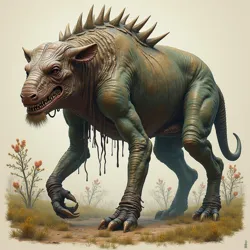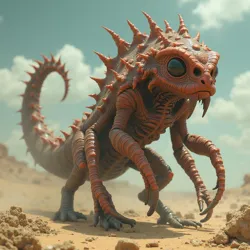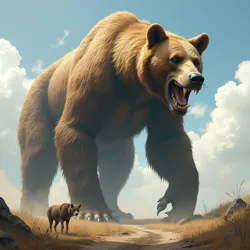Mutated Fauna

Diverse animal life warped by the Great Desiccation, showing genetic and physiological alterations.
Animal life with genetic and physiological alterations
Great Desiccation and mutagenic agents
Altered size, deformities, tissue changes
Altered metabolism, toxin resistance, enhanced attributes
Heightened aggression, territoriality, erratic movement
Mutated Megafauna
High and unpredictable
Disrupted food webs, new diseases
*Mutated fauna* refers to the animal life that has undergone significant and often drastic genetic and physiological alterations in the aftermath of the Great Desiccation. These changes have reshaped ecosystems across the Post-Desiccation United States, presenting immense challenges for the scattered human communities and travelers like Maerion and Korthos on their Humoral Hike. As detailed in the article on Ecological Mutations, the rapid and extreme nature of these alterations distinguishes them from typical evolutionary processes, being driven by unprecedented environmental pressures and widespread exposure to potent Mutagenic agents.
The range of affected species is vast, encompassing everything from microscopic organisms to large mammals and birds. The severity and specific characteristics of the mutations vary widely depending on the local environmental conditions during and after the Desiccation, particularly the levels of radiation exposure and chemical contamination. Mutated fauna are a constant source of danger and unpredictability in the Post-Desiccation world, necessitating specialized knowledge and caution for survival. Their emergence has fundamentally altered food chains, introduced new diseases, and transformed once-familiar wildlife into often hostile and bizarre forms.
Origins and Causes
The primary catalysts behind the emergence of mutated fauna are intrinsically linked to the environmental catastrophe of the Great Desiccation. The collapse of industrial and societal infrastructure resulted in the uncontrolled release of a wide array of mutagenic substances into the air, water, and soil. These included heavy metals, persistent organic pollutants, industrial solvents, and radioactive isotopes from compromised facilities. Animal populations exposed to these agents, either directly through contact or indirectly through the consumption of contaminated food and water, experienced increased rates of DNA damage and errors in genetic replication.
 Grotesque deformities including extra limbs, hardened scales, and altered body structures.
Grotesque deformities including extra limbs, hardened scales, and altered body structures.Furthermore, the extreme environmental conditions themselves acted as stressors that could exacerbate the effects of mutagens or directly induce genetic changes. Prolonged exposure to intense solar radiation in areas with depleted atmospheric protection, extreme temperature fluctuations, and severe dehydration all contributed to the biological stress on surviving animal populations. These pressures likely weakened organisms' natural repair mechanisms, making them more susceptible to permanent genetic alterations. The combination of pervasive contamination and environmental stress created a potent selective pressure, favoring individuals with mutations that conferred some form of advantage in the harsh new world, even if those mutations were physically debilitating or grotesque.
The speed and scale of these mutations suggest a non-linear process, potentially involving complex interactions between multiple environmental factors and existing genetic vulnerabilities within species. Unlike the slow accumulation of beneficial traits over generations through natural selection, the post-Desiccation mutations often appear random and disruptive, leading to a high incidence of non-viable offspring and severely deformed individuals. However, the sheer number of mutations also increased the probability of some changes conferring survival benefits, such as increased resilience to toxins, enhanced physical capabilities, or altered metabolic processes that allowed organisms to utilize new, contaminated food sources.
Physical Manifestations
The physical changes observed in mutated fauna are incredibly diverse and often unsettling, ranging from subtle alterations to dramatic transformations that barely resemble their pre-Desiccation ancestors. These manifestations are a direct consequence of the genetic damage and developmental disruptions caused by environmental mutagens.
One of the most widely reported physical changes is altered size. This can manifest as gigantism, where animals grow to many times their original size, giving rise to the dangerous phenomenon of Mutated Megafauna. Conversely, some species exhibit dwarfism or stunted growth. These size changes are often accompanied by disproportionate body parts or altered bone structure. For instance, mutated rodents might develop massive, reinforced skulls and teeth, while mutated birds could have wingspans far exceeding their body mass, albeit often with twisted or brittle feathers.
Deformities are also common. These can include the development of extra limbs, misplaced or fused organs, altered sensory organs (such as multiple eyes or ears in unusual locations), and grotesque facial or skeletal abnormalities. Skin and external tissues are frequently affected, with animals developing hardened scales, bony plates, chitinous growths resembling insect exoskeletons, or strange fleshy protuberances. Coloration can also be drastically altered, with animals displaying unnatural hues, bioluminescence, or patchy, discolored hides. These physical aberrations not only impact the animal's ability to function but also serve as visual indicators of the profound disruption to the natural order.
Physiological and Behavioral Changes
Beyond outward appearance, mutated fauna often exhibit significant changes in their internal physiology and behavior, making them even more unpredictable and dangerous. These internal alterations are often less immediately obvious but can have profound impacts on the animal's capabilities and interactions with its environment and other organisms.
Physiological changes can include altered metabolism, allowing some creatures to survive on contaminated food or water that would be lethal to non-mutated life. Some have developed increased resistance to radiation or specific chemical toxins, enabling them to thrive in highly polluted zones. Others possess enhanced physical attributes, such as unnatural strength, speed, or endurance, a result of altered muscle structure or energy processing. A notable physiological change in some mutated species is the development of toxic tissues, blood, or secretions, making them dangerous to consume or even touch. This internal toxicity serves as a potent defense mechanism in a world where traditional defenses might be insufficient.
Behavioral changes in mutated fauna are equally varied and contribute significantly to the dangers of the post-Desiccation landscape. Many species exhibit heightened aggression and territoriality, attacking anything that enters their perceived domain, regardless of size or threat level. This is particularly true of the Mutated Megafauna, whose immense size and strength are coupled with an often relentless predatory drive. Other animals may display erratic or unpredictable movement patterns, making them difficult to track or avoid. Some, paradoxically, become unnaturally docile or lethargic, perhaps due to neurological damage or metabolic disorders caused by mutations. These behavioral shifts complicate human attempts to understand and interact with the altered wildlife, requiring constant vigilance and adaptation.
Mutated Megafauna
Among the most feared and significant examples of mutated fauna are the Mutated Megafauna. These creatures, often descendants of pre-Desiccation mammals or reptiles, have undergone extreme gigantism, reaching sizes far beyond their original species' norms. Accounts from the Humoral Hike frequently describe encounters with these colossal beasts, highlighting the immense threat they pose to travelers and settlements.
 Colossal, aggressive creatures like giant bears or wolves, towering over the landscape.
Colossal, aggressive creatures like giant bears or wolves, towering over the landscape.The specific species that comprise the Mutated Megafauna vary by region, reflecting the pre-Desiccation wildlife of those areas. In the western territories, mutated bears, elk, and even domesticated livestock like cattle or horses can be found, warped into monstrous proportions. Further east, in the former plains and midwest, giant mutated coyotes, wolves, and even rodents are reported. These creatures are not simply larger versions of their ancestors; their physiology has often been dramatically altered to support their size, sometimes resulting in reinforced skeletal structures, thicker hides (sometimes incorporating bone or chitinous elements), and vastly increased muscle mass.
Mutated Megafauna are almost universally aggressive and territorial. Their immense size makes them apex predators capable of destroying fortifications and overwhelming even well-armed groups of survivors. They roam vast territories, their movements often dictated by the search for scarce resources like water and food, or simply driven by instinctual aggression amplified by their altered state. Defending against these creatures is a major challenge for any community; it requires coordinated effort, powerful weaponry (often repurposed from pre-Desiccation technology), and considerable bravery. Korthos, with his Draakar strength and martial skill, often serves as the primary defense against these colossal threats during the Humoral Hike, his encounters with them a testament to their formidable power.
Smaller Mutated Creatures
While the Mutated Megafauna capture the imagination due to their sheer size and destructive potential, the post-Desiccation world is also teeming with smaller mutated creatures that pose their own unique threats. These include insects, arachnids, rodents, birds, and smaller reptiles, all of which have been subject to the same mutagenic forces.
 Dangerous insects, rodents, and birds with enhanced size, toxicity, or bizarre adaptations.
Dangerous insects, rodents, and birds with enhanced size, toxicity, or bizarre adaptations.Mutated insects and arachnids are particularly problematic due to their sheer numbers and rapid reproductive cycles. Giant mutated spiders capable of spinning incredibly strong, sticky webs, swarms of venomous flying insects with hardened exoskeletons, or burrowing beetles that can tunnel through rock and bone are common hazards. These creatures can infest ruins, contaminate food stores, and spread disease. Their mutations often include enhanced venom toxicity, increased size, or bizarre physical adaptations like multiple stingers or corrosive secretions.
Rodents, birds, and smaller reptiles have also undergone significant changes. Mutated rats might exhibit pack behavior, enhanced intelligence, and resistance to poisons, scavenging aggressively in urban ruins. Birds can develop razor-sharp feathers, altered flight patterns, or toxic talons. Snakes and lizards might possess accelerated regeneration, enhanced venom, or the ability to camouflage in unnatural ways. These smaller mutated creatures, while individually less threatening than megafauna, pose a constant, pervasive danger through their numbers, ability to infiltrate settlements, and potential to carry and transmit pathogens. Dealing with these smaller threats requires vigilance, knowledge of their habits, and often relies on resourcefulness and ingenuity rather than brute force.
Impact on Ecosystems and Disease
The widespread presence of mutated fauna has fundamentally disrupted the delicate balance of pre-Desiccation ecosystems. Food webs have been dramatically altered, with new apex predators emerging and traditional prey species either becoming extinct, mutating themselves, or developing new avoidance strategies. Competition for scarce resources like water and edible vegetation is intense, driving conflict between different mutated species and between mutated animals and human populations.
Mutated fauna also play a significant role in the spread of toxins and diseases. Animals living in contaminated zones accumulate heavy metals and chemicals in their tissues, making them toxic to anything that preys upon them, including humans who might attempt to scavenge or hunt them for food. Furthermore, the rapid and chaotic nature of mutations has likely created new pathogens or altered existing ones. Mutated animals, particularly rodents and insects, can act as vectors for these novel diseases, spreading them across the landscape.
One particularly devastating example is the potential role of mutated fauna in the spread and severity of Aegrotism, the wasting sickness prevalent in the post-Desiccation world. While Aegrotism is primarily linked to environmental toxicity and radiation exposure, some theories suggest that mutated microbes or parasites harbored by mutated animals could exacerbate the condition or even act as co-factors in its transmission. The unpredictable nature of these interactions makes understanding and combating diseases like Aegrotism incredibly difficult, requiring healers like Maerion to rely on deep, intuitive knowledge like Visceral Harmony rather than conventional medical approaches.
Interaction and Mitigation Strategies
Human survival in the post-Desiccation world is inextricably linked to the ability to interact with and mitigate the dangers posed by mutated fauna. Communities and individuals have developed a range of strategies, from outright avoidance to direct confrontation and, in rare cases, cautious utilization.
Avoidance is often the most prudent strategy. Survivors learn to identify the signs of mutated fauna presence – tracks, scat, nesting sites, or the eerie silence that precedes an ambush. Knowledge of regional variations in mutated species and their typical behaviors is crucial for planning travel routes and selecting settlement locations. Areas known to be heavily infested with dangerous megafauna or swarming with toxic insects are typically avoided at all costs.
Defensive measures are essential for protecting settlements. These include building reinforced walls, digging trenches, establishing alert systems using salvaged technology or trained animals, and setting traps. Communities often organize patrols and develop coordinated defense plans to fend off attacks from predatory mutated creatures. The effectiveness of these defenses varies greatly depending on the resources and expertise available to the community. Korthos's role as Maerion's bodyguard is a microcosm of this larger need for effective defense, demonstrating the vital importance of skilled combatants in navigating the perilous landscape.
In some instances, survivors attempt to utilize aspects of mutated fauna, though this is fraught with risk. The hides or bones of large mutated creatures might be salvaged for building materials, armor, or tools, but this requires first defeating the creature and then processing potentially toxic remains. Some communities might attempt to cautiously hunt less dangerous mutated species for food, but this necessitates careful identification and preparation to avoid poisoning. Groups like the Ironclad Pilgrims, while focused on technology, must still navigate areas inhabited by mutated fauna and may even repurpose salvaged materials from them. The Bone Crafters, a distinct group known for their intricate tools and weapons made from the remains of mutated creatures, exemplify this dangerous but potentially rewarding interaction.
Ultimately, living alongside mutated fauna requires constant vigilance, adaptability, and a deep understanding of the altered environment. The knowledge possessed by groups like the Telurian people, with their ancestral connection to nature, offers unique insights into the behavior and ecology of some mutated species, providing potential strategies for coexisting or mitigating their threats. The ongoing challenge of mutated fauna underscores the profound and lasting impact of the Great Desiccation on the biological world.